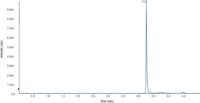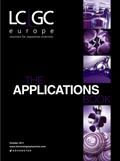A New Automated Approach for the Determination of Peptides in Human Plasma Using On-line SPE–LC–MS–MS
Spark Application Note
Introduction
A new approach for peptide analysis has been developed and evaluated — the integrated clean up and analysis of peptides using an on-line SPE procedure with a mixed mode strong anion exchange cartridge. Sample preparation has been simplified to just one operator step before the automated analysis of the samples.
Instrumentation
A Spark Holland Symbiosis Pico system with an Applied Biosystems API 4000 ESI-MS system were used for this application.
Experimental
Three peptides where received from Novo Nordisk (Malov, Denmark) for whom the method was developed (1). This application note shows the results for the 5900 AMU peptide but similar results were achieved for the 2100 and 6500 AMU peptide. Samples were prepared by spiking pooled human plasma with a 5900 amu peptide drug. Prior to extraction, all plasma samples were diluted 1:4 with water. 100 µL of diluted sample was then placed directly into the Symbiosis autosampler to undergo fully automated analysis. On-line SPE is performed on a disposable cartridge; each sample uses a fresh SPE cartridge. After extraction the peptides were eluted from the cartridge onto a reverse phase analytical column, using the HPD focusing mode. The mobile phases consist of formic acid (0.1%), water and methanol (95%) with separation on a Phenomenex Jupiter 4µm Proteo 50 × 2 mm LC column.
Results
The sample clean-up was optimized by increasing the percentage of organic modifier in the wash solvent. The mixed mode anion exchange cartridge allows for a high organic wash without reducing the analyte recovery. For optimal clean-up a first wash step with 20% ACN was programmed to remove interfering proteins (no denaturing on SPE cartridge), followed by a second high organic wash at 80% ACN to remove non-polar matrix compounds.

Figure 1: 5900 AMU peptide. Spiked plasma sample extracted on Oasis MAX (10 Ã 1 mm).
A clean and reproducible chromatogram was obtained (Figure 1). Subsequently, a calibration curve was determined by injecting a full set of calibration standards ranging from 0.5 to 500 ng/mL spiked human plasma standards. The calibration curve is calculated with a 1/X weighting. The curve for the peptide is displayed in Figure 2 (r > 0.996).

Figure 2: 5900 AMU peptide. Spiked plasma calibration curve from 0.5 to 500 ng/mL.
Conclusion
A simple sample preparation method has been developed for the determination of peptides in plasma. Automated on-line SPE–LC–MS–MS delivers clean and reproducible results. Good linearity was obtained in human plasma over the 0.5–500 ng/mL range (r > 0.996). The developed XLC–MS–MS method has an absolute recovery of more than 90%. The accuracy ranges from 89–117% and the precision 2.1–7.9%CV.
The Symbiosis Pico method is currently used routinely in several pharmaceutical labs for analysing different size of peptides (<10K amu) with similar results.
Reference
Spark Holland poster ASMS 2010: A new automated approach for the determination of peptides in human plasma using online SPE-LC-MS/MS
For more information please contact applications@sparkholland.com
Spark Holland BV
P. de Keyserstraat 8, PO Box 388, 7800 AJ Emmen, The Netherlands
E-mail: applications@sparkholland.com
Website: www.sparkholland.com

Silvia Radenkovic on Building Connections in the Scientific Community
April 11th 2025In the second part of our conversation with Silvia Radenkovic, she shares insights into her involvement in scientific organizations and offers advice for young scientists looking to engage more in scientific organizations.
Regulatory Deadlines and Supply Chain Challenges Take Center Stage in Nitrosamine Discussion
April 10th 2025During an LCGC International peer exchange, Aloka Srinivasan, Mayank Bhanti, and Amber Burch discussed the regulatory deadlines and supply chain challenges that come with nitrosamine analysis.
Removing Double-Stranded RNA Impurities Using Chromatography
April 8th 2025Researchers from Agency for Science, Technology and Research in Singapore recently published a review article exploring how chromatography can be used to remove double-stranded RNA impurities during mRNA therapeutics production.



















